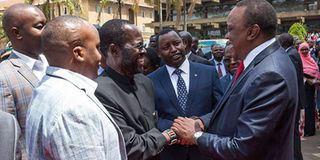Uhuru demands use of single tax collection system

President Uhuru Kenyatta (right) shares a light moment with Kisumu Governor Anyang' Nyongo during the presentation of the Joint National and Resource Mapping project status report at KICC on February 7, 2019. He said he wants an effective system for collecting revenue. PHOTO | NATION MEDIA GROUP
What you need to know:
- Mr Kenyatta said that the single revenue collection system will be integrated with the national system.
- He directed the Commission on Revenue Allocation, Council of Governors, National Treasury and KRA to form a multi-agency team that will deliver the system.
President Uhuru Kenyatta has ordered the creation of a single revenue collection system in the country.
The President lamented that the national and 47 county governments currently rely on 11 different revenue collection systems, leading to wastage of resources and duplication of efforts.
He directed the Commission on Revenue Allocation, Council of Governors, National Treasury and Kenya Revenue Authority to form a multi-agency team that will deliver the system.
“The disintegrated revenue collection system severely limits the amounts of revenue collected by both the national and county governments,” he said.
EFFECTIVE
Mr Kenyatta, who was speaking at KICC on Thursday, said that the single revenue collection system will be integrated with the national system.
“Multi-agency teams have been successful in delivering good results in various sectors such as Lapsset, immigration and border security, environment conservation and rejuvenation as well as the fight against corruption.
"This shows that the multi-agency model is an effective strategy which should be replicated across government,” he said while receiving a status report on the Joint National and Resource Mapping project.
The project was commissioned in May last year and is expected to help the country in planning and mapping out its resources.
MAPS
Surveying and mapping out resources is not only crucial in planning but also in finding the kind of resources the country has and where they are located.
Kenya has over the years been relying on outdated and inaccurate maps, some of which were developed before independence. Failure to identify natural resources also affects revenue collection for the two levels of governments.
As a result, the government was at times forced to rely on maps from private companies, which President Kenyatta noted are expensive, inconsistent, and not standardised.
“The use of old maps and those from the private sector resulted in development of chaotic urban areas,” Mr Kenyatta said. The project cost the government about Sh2 billion.
DATA COLLECTION
Meanwhile, Kakamega Governor Wycliffe Oparanya said that geospatial information remains crucial in helping county governments with information needed to address various issues in a timely and efficient manner.
Mr Oparanya, who is also Council of Governors chairman, noted that county governments are required to provide services in land management, agriculture, transport, basic education and trade, among others, which require integrated data.
Resource mapping, he said, is an important exercise that would help counties to collect data in different sectors for its planning.





